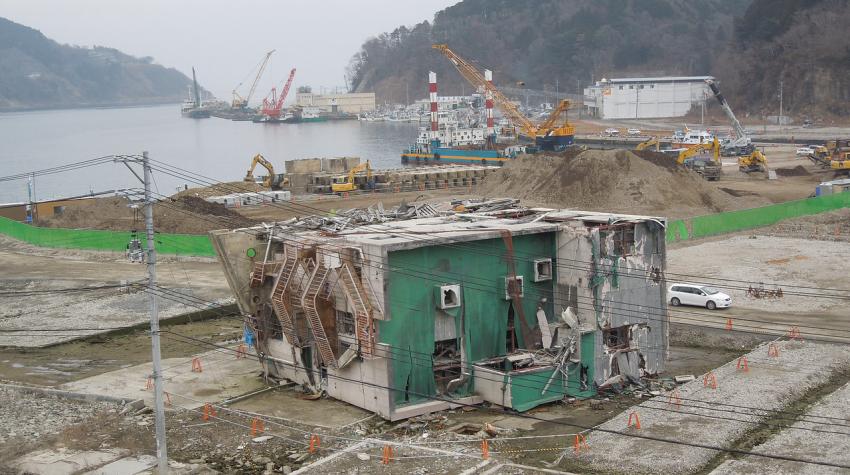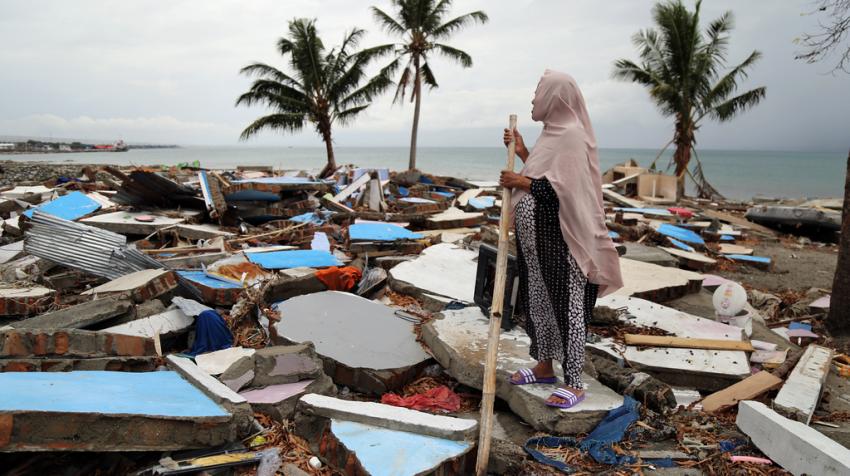4 November 2023
Tsunamis occur rarely but when they do, they are deadly—killing more than 250,000 people between 1998 and 2017. The highest death toll during that period was inflicted by the Indian Ocean tsunami in 2004, which claimed the lives of more than 227,000 people across 14 countries. In 2011, as a result of the Great East Japan Earthquake and ensuing tsunami, more than 22,000 people died or went missing.
The impact of tsunamis is not experienced evenly: the poor and those facing societal barriers often suffer the most. Elderly persons and persons with disabilities were found to be particularly vulnerable during the 2011 tsunami in Japan. In Sri Lanka and Indonesia in 2004, women were disproportionately affected.
Global warming is causing more frequent and intense storms and cyclones, the melting of glaciers and ice caps, and rising sea levels. Today, more than 700 million people live in low-lying coastal areas and in small island developing States, exposed to extreme sea-level events such as tsunamis but also to floods, landslides and other water-related hazards.
Half of the countries of the world lack adequate early warning systems—a critical tool for saving lives. As risks to human lives increase, so should our preparedness. The United Nations plays a central role in supporting countries in managing disaster risk and preparedness, as well as in the humanitarian response if a natural disaster does occur.
For this World Tsunami Awareness Day, we consider the linkages between inequality, tsunamis and climate change, and discuss the path that lies ahead for building resilience in communities around the world.
The uneven impact of tsunamis
Inequality can manifest itself most starkly during times of disaster. In any natural disaster or conflict, vulnerable people are likely to suffer more. Tsunamis are no exception.
In Japan, following the 2011 earthquake and tsunami, nearly 25 per cent of those who died due to illness or stress had disabilities, even though persons with disabilities accounted for only 7 per cent of the population.
The elderly were also vulnerable. Authorities noted that 66.1 per cent of victims from the earthquake and tsunami in the three most affected prefectures were 60 years of age and older—higher than their demographic share. Their reduced mobility and physical strength may have delayed evacuation.
The world’s most vulnerable populations are hit the hardest by climate change. Those living in fragile States that are experiencing ongoing conflict and political instability will have fewer means to cope with extreme weather events.
In terms of gender differences, in the case of Japan, household surveys showed that men had a higher mortality rate than women, particularly among the elderly. This could be attributed to their occupations—volunteer firefighters and civil servants issuing alerts, for instance, are likely to face greater risk—or their behaviour, such as being involved in rescue efforts.
In contrast, in Sri Lanka and Indonesia, it was found that up to four times as many women as men died in the 2004 tsunami. More women may have been killed during this event because they stayed behind to look for their children or other relatives, or they were unable to swim or climb trees and therefore couldn't escape.
The lack of a globally agreed methodology in tsunami mortality surveys and the small sample size applied to past surveys are some of the limitations in identifying risk factors and vulnerability characteristics during tsunamis. The disaster experiences in Japan, and in Sri Lanka and Indonesia, point to the criticality of ensuring that the diverse needs of vulnerable persons are integrated into all stages of disaster preparedness and response.
Climate crisis and vulnerability
The world’s most vulnerable populations are hit the hardest by climate change. Those living in fragile States that are experiencing ongoing conflict and political instability will have fewer means to cope with extreme weather events. Climate change is affecting food security due to increasing temperatures, changing precipitation patterns and greater frequency of extreme events.
In the midst of an unprecedented global food security crisis, the Global Report on Food Crises 2023, issued by the Food Security Information Network and the Global Network Against Food Crises, estimates that over a quarter of a billion people face acute hunger. Extreme weather phenomena, including consecutive and recurrent drought events in the Horn of Africa, coupled with sharp increases in food prices, have pushed levels of wasting among children to critical levels in several countries.
To avoid a downward spiral, countries and communities need to build systems that can prevent or better manage risk. This means investing in resilient infrastructure and early warning systems, and improving social and economic opportunities to reduce underlying vulnerability to hazards.

Early warning systems
The use of early warning systems for disasters is one of the most cost-effective and proven methods for reducing disaster deaths and losses. Investments in such systems and in preparedness have saved thousands of lives and hundreds of billions of dollars in damages.
The early warning system gap among countries is wide. Half of the world’s countries lack adequate systems, and even fewer have adopted legislation to connect these systems to preparedness and response. In March 2022, the United Nations Secretary-General launched the Early Warnings for All initiative, calling for $3.1 billion to cover every single person on Earth by 2027.
Early warning systems must be people-centred: they are only effective when communities are well informed about risks and know what to do in emergency situations. This means ensuring that people have equal access to information and pre-established evacuation routes and centres. Plans must take into account the different needs of vulnerable persons to ensure that no one is left behind.
During tsunamis, issuing timely and accurate warnings is crucial in triggering evacuations to higher ground. The early warning system in Japan is known to be the most advanced in the world in its scale and distribution. Launched in 2007, the nationwide earthquake early warning system detects tremors, calculates an earthquake’s epicentre and sends out warnings from its seismographs across the country.
The system in place in Japan has evolved significantly over the decades, based on painful lessons learned from past earthquake and tsunami experiences. As a result, the time required to issue warnings has shrunk from 19 minutes in 1983 to 7 minutes in 1993, and to within 3 minutes in 2011 during the earthquake and tsunami in the Tohoku region.
In 2011, however, the first tsunami warnings were based on an estimated earthquake magnitude of 7.9 on the Richter scale, predicting waves of 3 to 6 metres. Sea walls protect communities against tsunamis of this scale, and many people believed they did not need to evacuate. The electricity service then shut down, and all communications were cut off in the tsunami-affected areas.
The intensity and increased frequency of extreme weather events highlight the urgency of establishing early warning systems for all.
Revised warnings of tsunamis above 10 metres were issued 28 minutes after the initial earthquake. Tsunamis as high as 15 to 30 metres swept away entire communities. The magnitude of the earthquake was revised to 8.8 on the Richter scale the next day, and to 9.0 two days later—exceeding any prior estimates by seismologists.
More than 22,000 people died or went missing in the three most-affected prefectures in Japan. The disaster was also the costliest in world history, incurring $235 billion in damages.
Towards a resilient future
The intensity and increased frequency of extreme weather events highlight the urgency of establishing early warning systems for all. But this will not be enough, and it is imperative that all countries better manage risk, particularly for vulnerable communities that will likely be most affected.
Reducing the risk of future shocks is key to building resilience and achieving the Sustainable Development Goals (SDGs) of the 2030 Agenda, the targets of the Paris Agreement and the Sendai Framework for Disaster Risk Reduction 2015–2030.
The Secretary-General warned this year that the SDGs were “disappearing in the rear-view mirror”, and that there was an urgent need for “clear benchmarks on tackling poverty and exclusion, and on advancing gender equality”. Hard-won development gains are at risk, with the international community’s attention and resources increasingly absorbed by ongoing crises.
Addressing gaps in resilience will require unprecedented levels of investment and adaptation from the public and private sectors, particularly for vulnerable countries. Greater action is needed now. Disaster risk reduction, which lies at the nexus of development, humanitarian response and climate change, will strengthen resilience in each area, saving lives and ultimately advancing sustainable development.
The UN Chronicle is not an official record. It is privileged to host senior United Nations officials as well as distinguished contributors from outside the United Nations system whose views are not necessarily those of the United Nations. Similarly, the boundaries and names shown, and the designations used, in maps or articles do not necessarily imply endorsement or acceptance by the United Nations.




